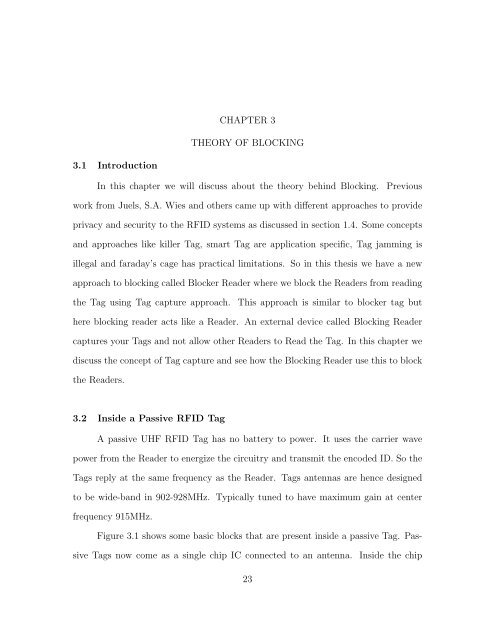BLOCKING READER: DESIGN AND IMPLEMENTATION OF A ...
BLOCKING READER: DESIGN AND IMPLEMENTATION OF A ...
BLOCKING READER: DESIGN AND IMPLEMENTATION OF A ...
Create successful ePaper yourself
Turn your PDF publications into a flip-book with our unique Google optimized e-Paper software.
3.1 Introduction<br />
CHAPTER 3<br />
THEORY <strong>OF</strong> <strong>BLOCKING</strong><br />
In this chapter we will discuss about the theory behind Blocking. Previous<br />
work from Juels, S.A. Wies and others came up with different approaches to provide<br />
privacy and security to the RFID systems as discussed in section 1.4. Some concepts<br />
and approaches like killer Tag, smart Tag are application specific, Tag jamming is<br />
illegal and faraday’s cage has practical limitations. So in this thesis we have a new<br />
approach to blocking called Blocker Reader where we block the Readers from reading<br />
the Tag using Tag capture approach. This approach is similar to blocker tag but<br />
here blocking reader acts like a Reader. An external device called Blocking Reader<br />
captures your Tags and not allow other Readers to Read the Tag. In this chapter we<br />
discuss the concept of Tag capture and see how the Blocking Reader use this to block<br />
the Readers.<br />
3.2 Inside a Passive RFID Tag<br />
A passive UHF RFID Tag has no battery to power. It uses the carrier wave<br />
power from the Reader to energize the circuitry and transmit the encoded ID. So the<br />
Tags reply at the same frequency as the Reader. Tags antennas are hence designed<br />
to be wide-band in 902-928MHz. Typically tuned to have maximum gain at center<br />
frequency 915MHz.<br />
Figure 3.1 shows some basic blocks that are present inside a passive Tag. Pas-<br />
sive Tags now come as a single chip IC connected to an antenna. Inside the chip<br />
23
















